Munich 2005 Robert Jorgensen
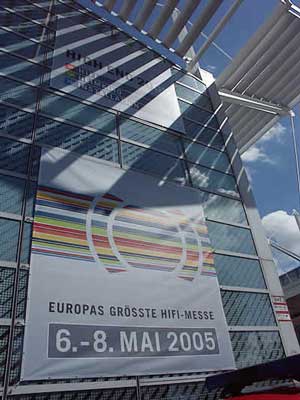
Since life puts great demands on my time I will start my impressions of HighEnd 2005 with what I perceived as personal highlights, showstoppers or whatever you want to call them. These are standout rooms and experiences that really makes trekking around shows like this for four days worth all the time and effort (sore feet included).
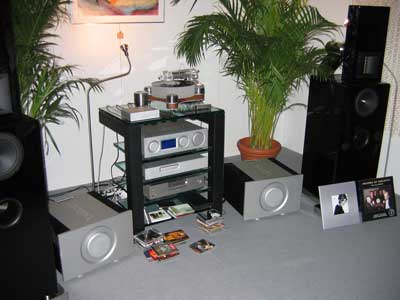
 It just tickles me pink how Ralf Ballmann and his team manages to incorporate their experience in hard-core industrial developments, like the network analysis equipment which form the core of their original business, into audiophile equipment in such a way as to produce some the most interesting and superb sound systems I can think of.
It just tickles me pink how Ralf Ballmann and his team manages to incorporate their experience in hard-core industrial developments, like the network analysis equipment which form the core of their original business, into audiophile equipment in such a way as to produce some the most interesting and superb sound systems I can think of.
Already last year I was bubbling over and this year there are more things to talk about.
Like quite a few other exhibitors they were fighting the acoustics of the cabins set up on the ground floor of the exhibition. While passing them several times in the first couple of days I was always on the way to somewhere or they were in the middle of talking to other people. That turned out to be my good luck. By the time I got around to them, the cabin (you can’t really call it a room) had been tuned in various ways and sounded pretty good.
All of the things we spoke about last year are still true and as exiting as ever. Two very interesting new products are available now though. One fits in as an integral part of the ‘behold’ chain i.e. it cannot exist outside it. The other could be a very interesting new part for someone adventurous, who still loves vinyl.
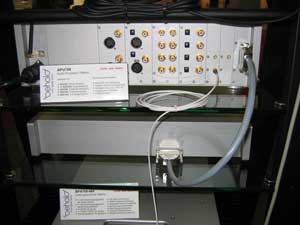 Let’s start with the CD player. It is a CD drive (and nothing but a CD drive) mounted in a CNC-routed 17 Kg block of Aluminium. Talk about mass and stability. The space to mount the drive has been routed out and a faceplate and sides are added. All processing and control is done on the CDP768 controller, which resides in the APU768 control unit. This extremely conveniently gets rid off all the compromises associated with the SP/DIF interface normally used between a drive and whatever device is processing its signals. It should be possible to get jitter really down and you can use the very secure transport build into the behold system with its low impedance professional interface, since the CDP768 not only controls the CD drive but also converts the standard PCM 44.1 kHz/16bit to the behold 768 kHz/24 bit format. Who says CD is dead?
Let’s start with the CD player. It is a CD drive (and nothing but a CD drive) mounted in a CNC-routed 17 Kg block of Aluminium. Talk about mass and stability. The space to mount the drive has been routed out and a faceplate and sides are added. All processing and control is done on the CDP768 controller, which resides in the APU768 control unit. This extremely conveniently gets rid off all the compromises associated with the SP/DIF interface normally used between a drive and whatever device is processing its signals. It should be possible to get jitter really down and you can use the very secure transport build into the behold system with its low impedance professional interface, since the CDP768 not only controls the CD drive but also converts the standard PCM 44.1 kHz/16bit to the behold 768 kHz/24 bit format. Who says CD is dead?
The other new product is really exiting for vinyl enthusiasts. It is the PDS192 digital riaa correction unit. Well actually it does digital domain phono equalizing, turntable motor control and power and acts as a PC interface if you would like to record your LP’s unto your home music server and I suppose it does the kitchen sink as well.
Just take a look inside this beauty, which Ralf Ballmann shows us with justified pride.
Before you scream “Heresy” I would advice you to take a closer look and most importantly a listen. I did and boy did it sound good. I certainly could not find any obvious ‘digital’ nastiness at all while listening for much too short a time.
The signal obviously enters as a normal analogue phono signal, which can be amplified, from 0 to 24 dB in 6 dB steps. This takes care of the major differences in level between moving magnet and the lower output moving coil designs. Immediately after the pre-amplification follows a 192 Khz/24 bit A/D conversion. A number of different equalizing curves are available from the front panel but you can create new ones yourself on a PC, which you can connect via USB. You can also bypass the phono equalizer leaving just the A/D converter. I know for sure that quite a few analogue addicts will cringe at this. They shouldn’t. Precise riaa correction is something very difficult to achieve, which is probably at least one reason why so many phono-stages sound so different.
Outputs include analogue out, digital out via sp/dif at a maximum of 192/96/48 kHz / 24 bits on coaxial as well as Toslink. And 48 kHz / 16 bit via USB. (I can’t help wishing they had gone straight for USB2 instead of the older USB1).
But another really interesting aspect is the motor section of the PDS192. A lot of turntable owners have invested a substantial sum in a power supply, perhaps with extensive filtering for their turntable motors. The PDS192 contains a high precision drive signal for synchronous motors with just about all the features you could dream of. Slow start, multiple voltages, extensive speed control for 3 individual speeds and I could go on. I actually hope I get a chance to do so at another time.
All in all the proof of the puddin’ was in the listening. And it was good. We listened to vinyl via MCA768 interface and via the PDS192. We listened to CDs on the CD-Player and I actually think the lovely Ascendo speakers sounded better than in the Ascendo room. Small groups, female vocals, blues, Elvis singing ‘Fever,’ Dean Peer playing ‘Ucross’ and Sergio Mendes’ Brasiliero with a hundred chaps banging the drums was all played with ease and poise. Wow!
ATE Transar shown by Rossner & Sohn
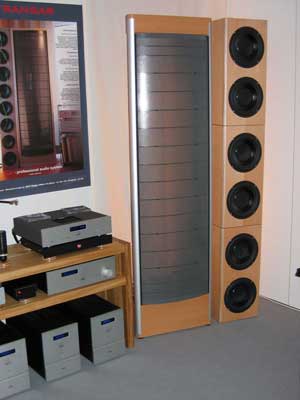 Actually I should ask forgiveness for not paying enough attention to the quite fantastic turntable exhibited by Rossner & Sohn (the last being German for, you guessed it, Son). It seems really interesting and if I get a chance I will certainly do penance and make up for it at another occasion.
Actually I should ask forgiveness for not paying enough attention to the quite fantastic turntable exhibited by Rossner & Sohn (the last being German for, you guessed it, Son). It seems really interesting and if I get a chance I will certainly do penance and make up for it at another occasion.
One reason I didn’t was that, after having been intrigued by the add in the exhibition catalogue, I just had to listen to these electrostatics which promised the ability to hit over 120 dBs. Now, don’t misunderstand me. I don’t normally make it a habit to listen music at those kinds of levels. But if you want a truly realistic portrayal of a big orchestra you do need awesome dynamics and a substantial maximum level, even if it isn’t sustained for very long. So I was really curious.
The actual demo was run by Max Schlundt who is a dealer from Berlin and what a demo that was. A suitable mix of wonderful music, real information about the system and a liberal sprinkling of anecdotes relating to these fantastic (and DO NOT take this lightly) speakers and the people who have bought them.
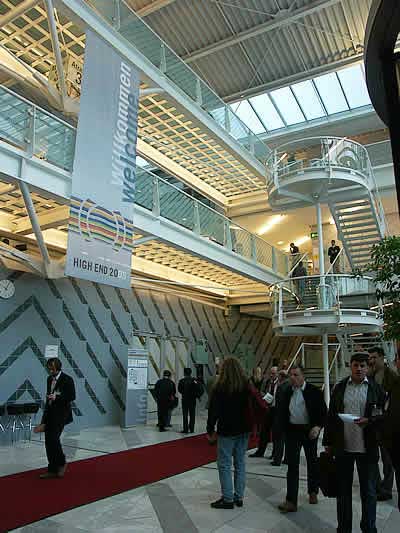
 At around 2 meters tall these are large speakers. Each side consists of a large electrostatic panel somewhat narrower than a Martin Logan CLS of yore but close enough to stir good memories. Next to them you find a substantial bass tower, which in its current incarnation has 6 bass units, where earlier versions had 8 slightly smaller ones.
At around 2 meters tall these are large speakers. Each side consists of a large electrostatic panel somewhat narrower than a Martin Logan CLS of yore but close enough to stir good memories. Next to them you find a substantial bass tower, which in its current incarnation has 6 bass units, where earlier versions had 8 slightly smaller ones.
Before going on to tell you about the speakers I will just mention that they are actively amplified with a Transar x-over which exists in both an analogue and a digital version. The digital version was used and the equalizing abilities it contains were put to extremely good use since the cabin had a relatively broad 20 dB dip between 55 and 75 Hz. At the show the speakers were driven by AudioNet mono amps, which as far as I could hear did admirable service.
One of the problems with most electrostatic speakers is that while they almost all have a wonderful way with delicate music and the larger ones offer line-source characteristics which gives a very present and dynamic sound, they almost all also fall short in having real oomph in the lower regions. That was the case with CLS which I otherwise really liked the sound of. Also most will not play very loud. This generally being bound in the system of passing the signal through a thin film suspended between two stators with a substantial voltage across them. If the film gets too close to stator you get a nice arc which could do nasty things to your film like burning a hole in it. Most of the time this is not good for sound.
Part of the design of the Transar is that it has been developed in co-operation with the Frauenhofer Institute which is a VERY respected technical institute in Germany and which you could very well know as the place where mp3 was invented (more or less).
Well how did it sound? In one word: MARVELOUS!!!
I honestly do not think I have ever heard a better electrostatic speaker. It does all the things you expect of it with finesse. Choir, guitar, female (and male) voices and violins. Oh yes. But it also BIG orchestra, Hip-Hop and the Sergio Mendes I mentioned above with an ease that seems slightly unreal.
As shown it was 30K€ which is not peanuts by anybody’s account. But I have no doubt that this is a world class speaker system that people with the means should listen to. So should anybody else for that matter just to hear what it can sound like.
Kudos to a very sympathetic Norman Gerkinsmeyer who not only is the prime mover in the development of the film technology used but also more or less build each system by hand.
I’ve started out telling you about some of the last things I heard and saw in Munich, but of course there were many other exciting things worth mention…
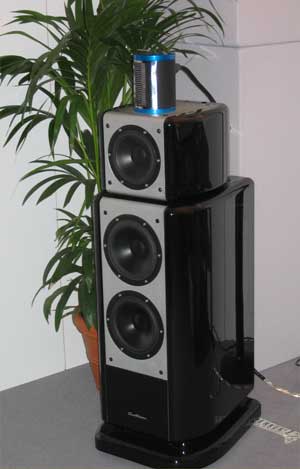 Sun Union Audio speakers from Hongkong (right) filled with mouth-watering European parts like bass- and mid-range units from Skaaning’s Audio Technology, Capacitors and Inductors from Jantzen and a new French ribbon tweeter from the father of the Raven.
Sun Union Audio speakers from Hongkong (right) filled with mouth-watering European parts like bass- and mid-range units from Skaaning’s Audio Technology, Capacitors and Inductors from Jantzen and a new French ribbon tweeter from the father of the Raven.
Audio Physics’ new Caldera with a brand new way of making a co-axial unit.
Exiting new dipole speakers from Audioelevationdriven by the latest version of the awesome Kronzilla amps.
Impressive horn systems from Avantgarde Acousticsand Martion
The best B&W Nautilus Series yet.
Sony’s impressive Qualia SXRD High Definition projector

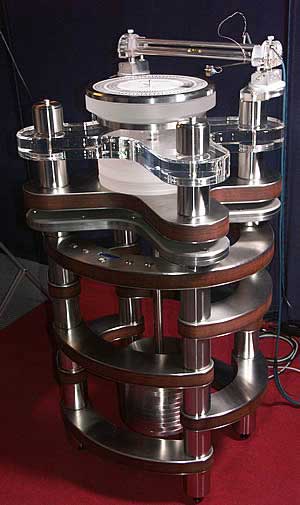
More than 80 turntables (we think) from ClearAudio, Transrotor, SME, Acoustic Solid, Rossner & Sohn and many others.
Until next year…
Stereo Times Masthead
Publisher/Founder
Clement Perry
Editor
Dave Thomas
Senior Editors
Frank Alles, Mike Girardi, Key Kim, Russell Lichter, Terry London, Moreno Mitchell, Paul Szabady, Bill Wells, Mike Wright, Stephen Yan, and Rob Dockery
Current Contributors
David Abramson, Tim Barrall, Dave Allison, Ron Cook, Lewis Dardick, Dan Secula, Don Shaulis, Greg Simmons, Eric Teh, Greg Voth, Richard Willie, Ed Van Winkle, and Rob Dockery
Music Reviewers:
Carlos Sanchez, John Jonczyk, John Sprung and Russell Lichter
Site Management Clement Perry
Ad Designer: Martin Perry





Be the first to comment on: Munich 2005 Robert Jorgensen